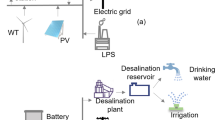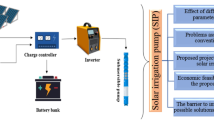Abstract
Water is the most fundamental need for better yield in agriculture. Worldwide, diesel and electricity are typically used to pump water which contributes to atmospheric pollution. Besides, a power outage affects the irrigation process badly. Without water, the crop may wither away, causing a substantial economic loss. This paper discusses the resilience of a solar PV system during a power outage. HOMER Pro software was used to perform the techno-economic analysis of solar-based irrigation for four major divisions of Bangladesh, while 1-hour power outage was assigned in REopt lite to model the survivability of the system against the grid outage. The simulation outcomes showed that the energy cost is $0.1496/kWh, $0.1502/kWh, $0.1557/kWh, and $0.1576/kWh for Rajshahi, Sylhet, Dhaka, and Chattogram, respectively. About 45% of excess electricity can be stored after fulfilling all requirements. The system is more economical than a microgrid-based water pumping system and a diesel-based system, and the photovoltaic system is technically and economically suitable to pump water if the nearest grid connection is impossible. When connected to the main utility grid, the system can survive without grid power for several hours, subject to daytime outages.









Similar content being viewed by others
Data availability
The data that support the findings of this study are available from the corresponding author, Tamal Chowdhury, upon reasonable request.
Abbreviations
- BADC:
-
Bangladesh Agriculture Development Corporation
- BMDA:
-
Barind Multipurpose Development Authority
- COE:
-
cost of energy
- CRF:
-
capital recovery factor
- IDCOL:
-
Infrastructure Development Company Limited
- NPC:
-
net present cost
- NREL:
-
National Renewable Energy Laboratory
- NOCT:
-
nominal operating cell temperature (°C)
- PDB:
-
Power Development Board
- RF:
-
renewable fraction
- REB:
-
Rural Electrification Board
- SIP:
-
solar irrigation pump
- SREDA:
-
Sustainable and Renewable Energy Development Authority
- C a ($/ year):
-
sum of every year capital, replacement and operational and maintenance cost of each component
- E demand :
-
total load demand
- E excess :
-
excess electricity (kWh.yr−1) generation from the renewable energy sources
- E production :
-
total electrical energy (kWh.yr−1) production from all the sources.
- E ren :
-
energy generated from renewable sources per year
- f :
-
annual inflation rate (%)
- f PV (%):
-
derating factor of PV
- H :
-
no. of hours during a year (8760)
- I T (kW/m2):
-
solar irradiation incident on the PV array
- I S (kW/m2):
-
incident solar irradiation at standard test conditions
- i :
-
annual real interest rate (%)
- i′:
-
nominal interest rate (%)
- L 0, dg :
-
fuel curve intercept coefficient
- L 1, dg :
-
fuel curve slope
- P dg :
-
electrical output of the generator
- PV:
-
photovoltaic
- N:
-
project lifetime
- T C (°C):
-
PV cell temperature
- T a (°C):
-
ambient temperature
- TS (°C):
-
PV cell temperature under standard test conditions (25°C)
- Y dg :
-
rated capacity of the generator
- Y PV (kW):
-
rated capacity of PV array
- η PV :
-
PV panel efficiency
- ɣ :
-
ground surface friction coefficient
- a,b :
-
constant
- α P :
-
temperature coefficient of power
References
Ali B (2018) Comparative assessment of the feasibility for solar irrigation pumps in Sudan. Renew Sust Energ Rev 81:413–420. https://doi.org/10.1016/j.rser.2017.08.008
Ali, T., Chiu, Y.-R., Aghaloo, K., Nahian, A. J., & Hongzhong. (2020). Prioritizing the existing power generation technologies in Bangladesh’s clean energy scheme using a hybrid multi-criteria decision-making model. J Clean Prod, 121901. https://doi.org/10.1016/j.jclepro.2020.121901
Aziz S, Chowdhury AS (2021) Performance evaluation of solar mini-grids in Bangladesh: a two-stage data envelopment analysis. Cleaner Environmental Systems 2:100003. https://doi.org/10.1016/j.cesys.2020.100003
BADC, Bangladesh Agricultural Development Corporation. Available at: http://www.badc.gov.bd/. (Accessed 1 Mar 2021).
BARC, Bangladesh Agricultural Research Council. Available at: http://www.barc.gov.bd/. (Accessed 1 Mar 2021).
Chahartaghi M, Nikzad A (2020) Exergy, environmental, and performance evaluations of a solar water pump system. Sustainable Energy Technologies and Assessments 100933
Chilundo RJ, Neves D, Mahanjane US (2019) Photovoltaic water pumping systems for horticultural crops irrigation: advancements and opportunities towards a green energy strategy for Mozambique. Sustainable Energy Technologies and Assessments 33:61–68. https://doi.org/10.1016/j.seta.2019.03.004
Chowdhury, S.A. (2020). National Solar Energy Roadmap, 2021 – 2041. Available at: http://www.sreda.gov.bd/. Accessed: 1/3/2021.
Das BK, Hasan M (2021) Optimal sizing of a stand-alone hybrid system for electric and thermal loads using excess energy and waste heat. Energy 214:119036. https://doi.org/10.1016/j.energy.2020.119036
Das BK, Tushar MSHK, Zaman F (2021) Techno-economic feasibility and size optimisation of an off-grid hybrid system for supplying electricity and thermal loads. Energy 215:119141. https://doi.org/10.1016/j.energy.2020.119141
Hafez O, Bhattacharya K (2012). Optimal break-even distance for design of microgrids. 2012 IEEE Electrical Power and Energy Conference. https://doi.org/10.1109/epec.2012.6474938.
Halabi LM, Mekhilef S, Olatomiwa L, Hazelton J (2017) Performance analysis of hybrid PV/diesel/battery system using HOMER: a case study Sabah, Malaysia. Energy Convers Manag 144:322–339. https://doi.org/10.1016/j.enconman.2017.04.070
Haque N (2018). Solar irrigation in Bangladesh: opportunities and challenges. Presented by: Infrastructure Development Company Limited (IDCOL). Available at: iorec.irena.org. Accessed: (1/3/2021)
Homer Pro Software. Available at: https://www.homerenergy.com/products/pro/index.htm (Accessed 21 Jan 2021).
Hoque MN, Nandi SK (2012) Feasibility study of a renewable power plant at Kuakata in Bangladesh. Environmental Science: An Indian Journal 7:108–120
Hossain MA, Hassan MS, Mottalib MA, Ahmmed S (2015a) Technical and economic feasibility of solar pump irrigations for eco-friendly environment. Procedia Engineering 105:670–678. https://doi.org/10.1016/j.proeng.2015.05.047
Hossain MA, Hassan MS, Mottalib MA, Hossain M (2015b) Feasibility of solar pump for sustainable irrigation in Bangladesh. Int J Energy Environ Eng 6(2):147–155. https://doi.org/10.1007/s40095-015-0162-4
Islam MR, Sarker PC, Ghosh SK (2017) Prospect and advancement of solar irrigation in Bangladesh: a review. Renew Sust Energ Rev 77:406–422. https://doi.org/10.1016/j.rser.2017.04.052
Ismail H (2016) Climate change, food and water security in Bangladesh. Strategic Analysis Paper. Future Directions international. Available at: https://www.futuredirections.org.au. (Accessed at: 13/5/2021).
Khan MT-A-I, Sarkar S, Hossain S, Ahmed AU, Pathik BB (2014). The feasibility study of solar irrigation: economical comparison between diesel and photovoltaic water pumping systems for different crops. 2013 International Conference on Electrical Information and Communication Technology (EICT). https://doi.org/10.1109/eict.2014.6777844
Lu J, Wang W, Zhang Y, Cheng S (2017) Multi-objective optimal design of stand-alone hybrid energy system using entropy weight method based on HOMER. Energies 10(10):1664. https://doi.org/10.3390/en10101664
Maliszewski PJ, Larson EK, Perrings C (2012) Environmental determinants of unscheduled residential outages in the electrical power distribution of Phoenix, Arizona. Reliab Eng Syst Saf 99:161–171. https://doi.org/10.1016/j.ress.2011.10.011
Mandal S, Das BK, Hoque N (2018) Optimum sizing of a stand-alone hybrid energy system for rural electrification in Bangladesh. J Clean Prod. https://doi.org/10.1016/j.jclepro.2018.07.257
Masrur H, Senjyu T, Islam MR, Kouzani AZ, Mahmud MAP (2020) Optimal operation of resilient microgrids during grid outages. IEEE International Conference on Applied Superconductivity and Electromagnetic Devices (ASEMD), Tianjin, China, 2020, 1-2, https://doi.org/10.1109/ASEMD49065.2020.9276171
Masrur H, Senjyu T, Islam MR, Kouzani AZ, Mahmud MAP (2021) Resilience-oriented dispatch of microgrids considering grid interruptions. IEEE Trans Appl Supercond 31(8):1–5. https://doi.org/10.1109/TASC.2021.3094423
NASA Surface meteorology and solar energy. Available at: http://eosweb.larc.nasa.gov/sse/ (Accessed 21 Jan 2021).
Niajalili M, Mayeli P, Naghashzadegan M, Poshtiri AH (2017) Techno-economic feasibility of off-grid solar irrigation for a rice paddy in Guilan province in Iran: a case study. Sol Energy 150:546–557. https://doi.org/10.1016/j.solener.2017.05.012
Nikzad A, Chahartaghi M, Ahmadi MH (2019) Technical, economic, and environmental modeling of solar water pump for irrigation of rice in Mazandaran province in Iran: a case study. J Clean Prod 118007. https://doi.org/10.1016/j.jclepro.2019.118007
Parvaresh Rizi A, Ashrafzadeh A, Ramezani A (2019) A financial comparative study of solar and regular irrigation pumps: case studies in eastern and southern Iran. Renewable Energy, Elsevier 138(C):1096–1103
Patil S, Kenia N, Gunatilake H (2021) Divide and prosper? Impacts of power-distribution feeder separation on household energy-use, irrigation, and crop production. Energy Policy, Elsevier 156(C)
Powell JW, Welsh JM, Pannell D, Kingwell R (2019) Can applying renewable energy for Australian sugarcane irrigation reduce energy cost and environmental impacts? A case study approach. J Clean Prod 240:118177. https://doi.org/10.1016/j.jclepro.2019.118177
Rana J, Kamruzzaman M, Hosain Oliver M, Akhi K (2020). Financial and factors demand analysis of solar powered irrigation system in Boro rice production: a case study in Meherpur district of Bangladesh. Renewable Energy. https://doi.org/10.1016/j.renene.2020.11.100
Rathore PKS, Das SS, Chauhan DS (2018) Perspectives of solar photovoltaic water pumping for irrigation in India. Energy Strategy Reviews 22:385–395. https://doi.org/10.1016/j.esr.2018.10.009
REopt Lite API (2020) URL: https://github.com/NREL/REopt_Lite_API, [Online; Accessed 09 Apr 2020]
Rezk H, Abdelkareem MA, Ghenai C (2019) Performance evaluation and optimal design of stand-alone solar PV-battery system for irrigation in isolated regions: a case study in Al Minya (Egypt). Sustainable Energy Technologies and Assessments 36:100556. https://doi.org/10.1016/j.seta.2019.100556
Sarkar MNI, Ghosh HR (2017) Techno-economic analysis and challenges of solar powered pumps dissemination in Bangladesh. Sustainable Energy Technologies and Assessments 20:33–46. https://doi.org/10.1016/j.seta.2017.02.013
Shoeb M, Shafiullah G (2018) Renewable energy integrated islanded microgrid for sustainable irrigation—a Bangladesh perspective. Energies 11(5):1283. https://doi.org/10.3390/en11051283
SREDA (2020) Sustainable and Renewable Energy Development Authority, Power Division, MPEMR, GOB, 2020. [Online]. Available: http://www.sreda.gov.bd/. Accessed: 1/3/2021
World Bank (2015). Solar-powered pumps reduce irrigation costs in Bangladesh. Available at. http://www.worldbank.org/en/results/2015/09l08/solar-powered-pumps-reduce-irrigation-costs-Bangladesh. (Accessed in 28 Feb 2021).
Yavuz AH (2020) Solar thermoelectric generator assisted irrigation water pump: design, simulation and economic analysis. Sustainable Energy Technologies and Assessments 41:100786. https://doi.org/10.1016/j.seta.2020.100786
Yu Y, Liu J, Wang Y, Xiang C, Zhou J (2018) Practicality of using solar energy for cassava irrigation in the Guangxi Autonomous Region, China. Appl Energy 230:31–41. https://doi.org/10.1016/j.apenergy.2018.08.060
Zou X, Li Y, Cremades R, Gao Q, Wan Y, Qin X (2013) Cost-effectiveness analysis of water-saving irrigation technologies based on climate change response: a case study of China. Agric Water Manag 129:9–20. https://doi.org/10.1016/j.agwat.2013.07.004
Acknowledgements
The current study did not receive any funding from any commercial and non-commercial sources.
Author information
Authors and Affiliations
Contributions
Simulation (HOMER Pro): Tamal Chowdhury, Hemal Chowdhury; simulation (REopt): Hasan Masrur. Writing and editing: Tamal, Hemal, Salman, and Hasan. Supervision: Tomonobu Senjyu.
Corresponding author
Ethics declarations
Ethics approval and consent to participate
The facts and views in the manuscript are solely ours, and we are responsible for authenticity, validity, and originality. We also declare that this manuscript is our original work, and we have not copied it from anywhere else. No plagiarism is detected in this manuscript.
Consent for publication
We undertake and agree that the manuscript submitted to your journal has not been published elsewhere and has not been simultaneously submitted to other journals.
Competing interests
The authors declare no competing interests.
Additional information
Responsible Editor: Philippe Garrigues
Publisher’s note
Springer Nature remains neutral with regard to jurisdictional claims in published maps and institutional affiliations.
Rights and permissions
About this article
Cite this article
Chowdhury, H., Chowdhury, T., Rahman, M.S. et al. A simulation study of techno-economics and resilience of the solar PV irrigation system against grid outages. Environ Sci Pollut Res 29, 64846–64857 (2022). https://doi.org/10.1007/s11356-022-20339-2
Received:
Accepted:
Published:
Issue Date:
DOI: https://doi.org/10.1007/s11356-022-20339-2




